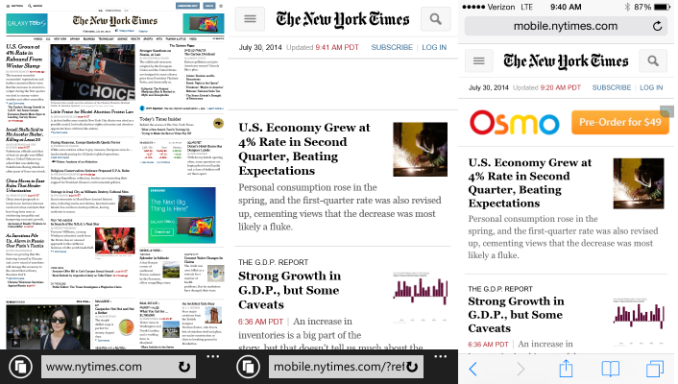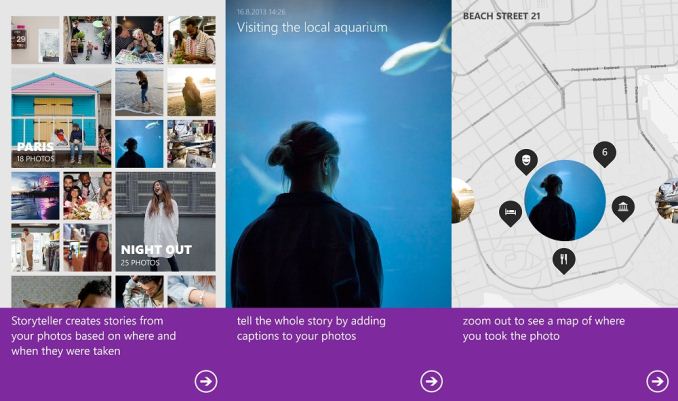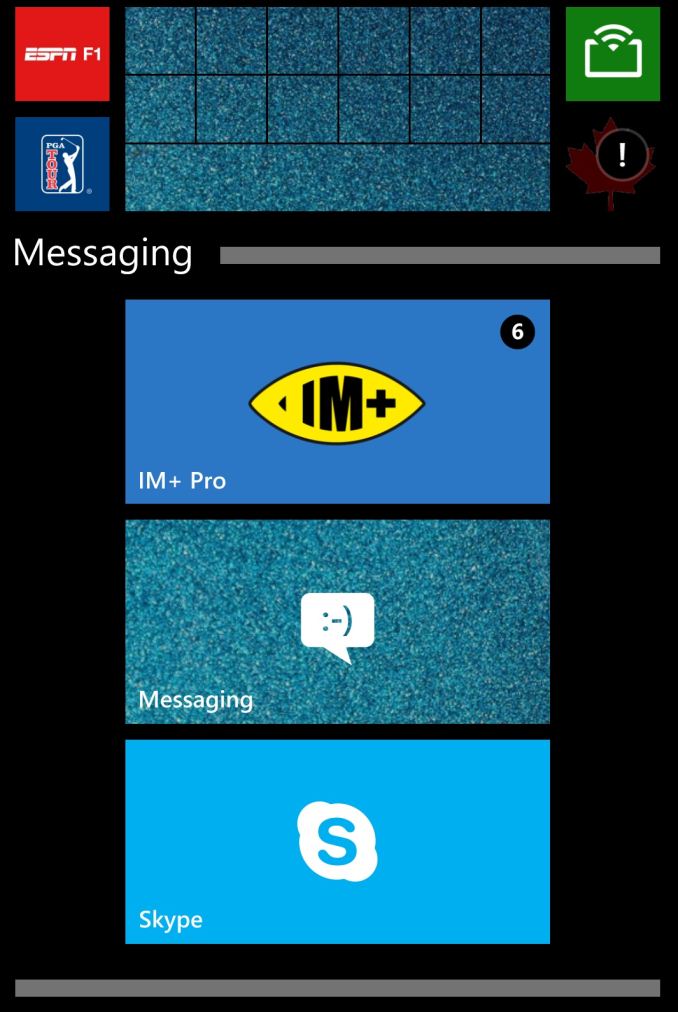Nokia Lumia 930 Review
by Brett Howse on September 8, 2014 3:00 PM EST- Posted in
- Smartphones
- Microsoft
- Nokia
- Mobile
- windows phone
- Lumia
Software
Like the Lumia 630, the 930 ships with Lumia Cyan firmware, which adds a few additions to the phone. Unlike Android phones, there is no customization of the operating system itself, so in this section we will take a look at several of the unique Nokia apps as well as improvements to Windows Phone 8.1 since it launched a few months ago.
As with the Lumia 630, Cyan finally brings adjustable display brightness as well as advanced color profiles. In addition, the lock screen timeout can now be set to “never” which was not always possible on older Nokia Windows Phones.
You also get access to the excellent HERE branded navigation apps, with HERE Drive+ for driving, HERE Maps as a general navigation app, and HERE Transit for using public transportation. They are a great alternative to Google Maps, which, as with most Google services, do not exist as a first party app on Windows Phone.
SensorCore, explained in the Lumia 630 review, is a low power portion of the Snapdragon 800 SoC which allows the phone to act like a pedometer. At IFA 2014, Microsoft announced that SensorCore is going to expand its capabilities this fall as well with the addition of "Hey Cortana" passive activation of Windows Phone's digital assitant to bring it parity with "Ok, Google" on the Android platform.
Microsoft is in the middle of transitioning the Nokia branded apps to Lumia apps, which makes sense with the acquisition of Nokia a few months ago. One example is the Nokia Storyteller app, now rebranded Lumia Storyteller. Storyteller collects your photographs and groups them by date and location into videos set to music, similar to HTC’s highlights reel. It is a neat feature and it does a good job with the photos if you like that sort of thing.
Storyteller works in conjunction with the “capture living images” option in the camera settings. This setting makes the camera capture a short amount of video prior to each photo being taken. Then, when scrolling through your camera roll, the images will have a bit of movement to them. It is an interesting, if creepy effect. This setting does not affect the still photo itself and must be stored separate from the image. Here is a video from Nokia showing it in action.
If living images in your camera roll creep you out, you can disable them in the Nokia camera settings.
The latest version of Windows Phone also brought some changes that are worth mentioning. First, the browser has been enhanced to give a better mobile experience. It has certainly helped out with mobile sites, with the caveat that you will often be offered access to the iPhone app for a site. One thing that would still be a great addition to Windows Phone’s browser is a navigation button to jump to the top of the page. Hopefully this will come soon.
 IE 11 old (left) IE 11 new (center) Safari (right)
IE 11 old (left) IE 11 new (center) Safari (right)
The other major addition since Windows Phone 8.1 was launched is native folder support. Being Windows Phone, these folders would not be much good if they did not support the live tile nature of the operating system, so they are live folders. To create a folder, do a long tap on a live tile and then drag it over another live tile. Tap a folder to expand it, and tap again to close it up. It is fast, simple, and actually works really well.
In addition, Bluetooth is updated for PAN 1.0 profile, aptX codec support for A2DP, and browsing support for AVRCP are now supported. NTP was for some reason never supported in earlier versions of the OS, with Windows Phone instead relying on carriers providing the time over the cellular network. That is not ideal as not all carriers do this properly, and if you do not have a SIM in your phone your time must be set manually, and then it wipes it out every time you reboot. This obvious addition of NTP support rectifies these shortcomings. For a full list of the changes, please see this page.
It always seems like Windows Phone is behind a bit compared to other mobile platforms, but these incremental updates are a good step to closing that gap. There are quite a few behind the scenes changes as well for this update so if Microsoft wants to have any chance to catch up, this is important.













115 Comments
View All Comments
pjcamp - Tuesday, September 9, 2014 - link
Not a dev. THE dev. Marcus Duarte himself claimed that users find two storage locations confusing.How we've muddled along with multiple storage locations on laptops all these years must confuse HIM to no end.
Besides this is Linux. It is possible to make a single file system spanning multiple devices. There's no reason Android couldn't clear up the "confusion" that way.
tuxRoller - Tuesday, September 9, 2014 - link
This ^I guess they've never heard of lvm/MD/btrfs.
Alexvrb - Tuesday, September 9, 2014 - link
That's not limited to Linux. I mean heck there's multiple approaches, some are completely software agnostic.Anyway, MS tried something like that with Windows Phone 7. It creates another problem when the user wants to REMOVE the memory card any time they want (users are stupid, this was a common complaint with WP7 I kid you not, result was WP8 separating the two again). WP 8.1 has a better middle-ground solution. Keep the spaces seperate but make better (and easier) use of the memory card.
BMNify - Monday, September 8, 2014 - link
Then get Lumia 1520 or 1320 or 630 or soon to be released Lumia 830 and 730, loads of options for MicroSD fanatics.jimbo2779 - Monday, September 8, 2014 - link
The issue is that this is meant to be the flagship phone at a reasonable size, the 1520 and 1320 are too big for the majority of users, the 830 is running a far inferior SoC, less RAM, poorer quality screen and camera, everything lower is in the same boat as the 830 or even worse so really the lack of SD card support here is it's main disappointment.I was looking forward to this phone so much only to find out it had no SD card support, any user of a Lumia (or other WP phone) with SD card support knows that it is so easy to use and allows for much more space than is available in a phone.
Would you rather have a phone with 32Gb or 96Gb? I know which I would prefer and I definitely would have bought a 930 outright to replace my 925 as this is an upgrade in every way but for some unknown reason they decided to make it the only phone in this years line-up without SD card support meaning it is a no go for me.
Reflex - Monday, September 8, 2014 - link
The question is what feature would you drop in order to gain that MicroSD slot? Because the 930/Icon is packed very tightly, it has everything that is in the 1520, yet in a full inch smaller package. Furthermore, it is barely larger overall than most 4.5" phones, so they really packed it tight.I am not willing to go with a larger phone. The features they did include are all very useful to me, I'd be pissed to lose, say, Qi charging, for a SD slot. I get that you want it all, but there are tradeoffs. Either you get the 930 with SD but without something else that takes up space, or you get it without SD support, or you get a larger phone that has all of it included (1520). The reason the 1520 exists is because there are some who are not willing to compromise. Quite frankly the 1520 is the phone you should be looking at, it was made with you in mind.
Also, the 520 has a SD slot not because its a high end feature but because it permits them to sell a phone with very little integrated storage, putting that part of the cost in the hands of the buyer.
Samus - Monday, September 8, 2014 - link
Most SD cards are slow, the controllers are slow, both add complexity and space to the PCB, most people rarely, if ever, use them, and most importantly, they drain the battery.If I were designing a small phone, I wouldn't put in external storage, either. Phablets and Tablets, sure...but with everything (especially WP8) becoming cloud-centric now, I don't see the need for physical media in a phone.
ummduh - Monday, September 8, 2014 - link
The cloud this, the cloud that, cloud, cloud, cloud cloud cloud.Do none of you people ever go outside the city you live in? End up in the mountains? The woods? A back country road that just happens to not have a signal?
I spend sometimes weeks on job sites out in the middle of nowhere with no signal. No wifi, either, since, ya know, it's a job site.
The cloud is 100% useless in those situations. Yea it's a neat toy, and can be handy when you never ever lose service. And you're willing to pay more and more for less and less data service.
Otherwise, you need storage on the device. 16GB, 32GB doesn't cut it. An endless supply is 64-128GB mSD cards, however, does. After apps are installed, I can only put a couple GB of music on my phone before it's filled. And then I get nagged to death by low storage warnings.
The cloud can go screw itself.
Reflex - Monday, September 8, 2014 - link
And in your situation that makes sense. However that is an edge case and the market really isn't, nor should it be, tailored to edge cases. Also, as someone who has compared coverage between carriers, I strongly suggest Verizon which tends to work just about everywhere, even in the backwoods, at least in the northern half of the country.ummduh - Monday, September 8, 2014 - link
So, I should pay extra amounts of money, every month, to stream the same data over and over to my phone, instead of carrying said data on my phone to begin with, and not keep incurring ever increasingly exorbitant monthly fees? What sense does that make?Pay to have the amount of data I'd need monthly (10GBish), over, and over, and over, and over.. etc. Or, $25 mSD?
It's not market tailoring, it's data fees extortion.